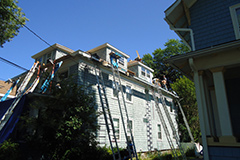
 Request A Free EstimateSchedule A Free Estimate
Request A Free EstimateSchedule A Free Estimate


It is easy to think of roof damage after events such as hail, ice storms, tornadoes, or hurricanes; but the winds can have some serious effects on roofs as well. Seasonal changes, such as the adjustment from cold weather to hot, often bring clashing elements in the skies. The resulting storms can sometimes bring strong straight winds. When these winds come without hail or excessive moisture, many don't give a second thought to their roof. However, these winds exert serious pressure that may cause damage that will not appear until the next heavy rain shower.
While a mild tornado has wind speeds of 73 to 112 miles per hour, it may not be uncommon to have straight winds that come with similar speeds. Winds at this level exert tremendous pressure when they come against the surfaces on your roof. Not all areas of the roof will receive equal amount of stress from the wind. If the wind comes against a flat area of the roof, it may not receive any damage. If, however, the wind comes across edges and corners of the roof, it can lift parts of the roof, cause curling, tears, and other damage. Even a small section of damage can have serious repercussions.
Damage caused by the wind depends on the size, shape, and angle of the roof, as well as the direction of the wind. Wind can exert positive pressure (pushing), or negative pressure (sucking). Positive pressure puts more stress on the structural components of the roof, while negative pressure tends to lift materials from the roof.
You may not live in a war zone, but you can certainly still sustain shrapnel damage to your roof. Strong winds carry debris and lash them against the surface of your roof. This debris can puncture or slice your roofing material, which could allow water leakage, or create a surface that further wind will continue to lift up, causing further damage.
The best prevention for wind damage is a well-built roof. A properly constructed roof is able to resist wind damage, saving you money down the road.
If you think your roof has been damaged by wind, you need to seek professional help before rains begin to do greater damage. A professional roofer can quickly and expertly take care of small problems before they cause greater damage.